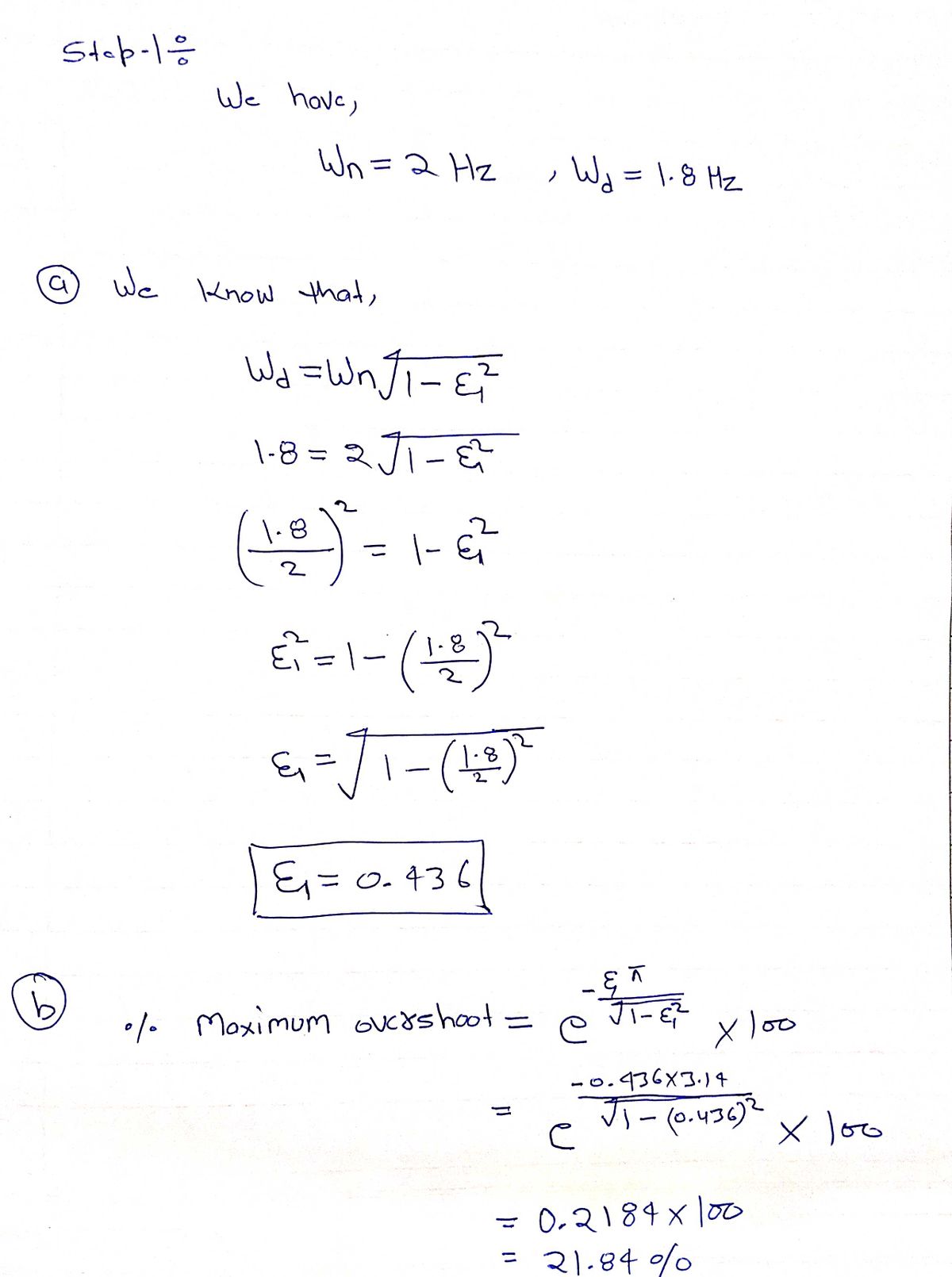A second-order system has a natural frequency of 2.0 Hz and a damped natural frequency of 1.8 Hz. What, for this damping, is (a) the damping ratio, (b) the percentage maximum overshoot, (c) the 2% settling time, (d) the number of cycles of oscillations that will occur within this settling time?
A second-order system has a natural frequency of 2.0 Hz and a damped natural frequency of 1.8 Hz. What, for this damping, is (a) the damping ratio, (b) the percentage maximum overshoot, (c) the 2% settling time, (d) the number of cycles of oscillations that will occur within this settling time?
Introductory Circuit Analysis (13th Edition)
13th Edition
ISBN:9780133923605
Author:Robert L. Boylestad
Publisher:Robert L. Boylestad
Chapter1: Introduction
Section: Chapter Questions
Problem 1P: Visit your local library (at school or home) and describe the extent to which it provides literature...
Related questions
Question
Thanks

Transcribed Image Text:**Topic: Second-Order System Damping Analysis**
A second-order system has a natural frequency of 2.0 Hz and a damped natural frequency of 1.8 Hz. We want to determine the following parameters for this system:
1. **Damping Ratio (ζ):** Calculate the damping ratio that affects the system's behavior.
2. **Percentage Maximum Overshoot:** Determine the percentage by which the system overshoots its final value.
3. **2% Settling Time:** Find the time it takes for the system to remain within 2% of its final value.
4. **Number of Cycles of Oscillations:** Calculate how many cycles of oscillation occur within the 2% settling time.
This analysis is critical in understanding the dynamic response of control systems and mechanical vibrations.
Expert Solution
Step 1

Step by step
Solved in 2 steps with 2 images

Knowledge Booster
Learn more about
Need a deep-dive on the concept behind this application? Look no further. Learn more about this topic, electrical-engineering and related others by exploring similar questions and additional content below.Recommended textbooks for you

Introductory Circuit Analysis (13th Edition)
Electrical Engineering
ISBN:
9780133923605
Author:
Robert L. Boylestad
Publisher:
PEARSON

Delmar's Standard Textbook Of Electricity
Electrical Engineering
ISBN:
9781337900348
Author:
Stephen L. Herman
Publisher:
Cengage Learning

Programmable Logic Controllers
Electrical Engineering
ISBN:
9780073373843
Author:
Frank D. Petruzella
Publisher:
McGraw-Hill Education

Introductory Circuit Analysis (13th Edition)
Electrical Engineering
ISBN:
9780133923605
Author:
Robert L. Boylestad
Publisher:
PEARSON

Delmar's Standard Textbook Of Electricity
Electrical Engineering
ISBN:
9781337900348
Author:
Stephen L. Herman
Publisher:
Cengage Learning

Programmable Logic Controllers
Electrical Engineering
ISBN:
9780073373843
Author:
Frank D. Petruzella
Publisher:
McGraw-Hill Education

Fundamentals of Electric Circuits
Electrical Engineering
ISBN:
9780078028229
Author:
Charles K Alexander, Matthew Sadiku
Publisher:
McGraw-Hill Education

Electric Circuits. (11th Edition)
Electrical Engineering
ISBN:
9780134746968
Author:
James W. Nilsson, Susan Riedel
Publisher:
PEARSON

Engineering Electromagnetics
Electrical Engineering
ISBN:
9780078028151
Author:
Hayt, William H. (william Hart), Jr, BUCK, John A.
Publisher:
Mcgraw-hill Education,